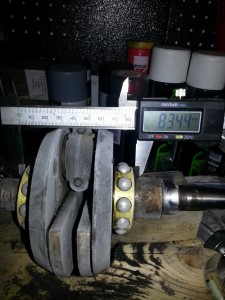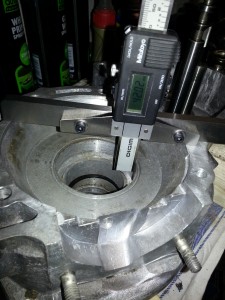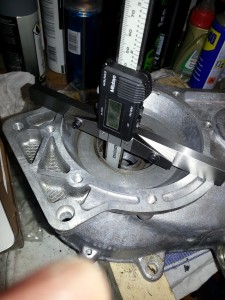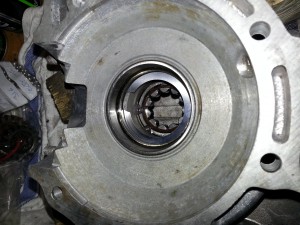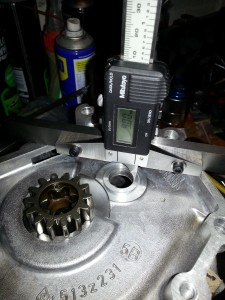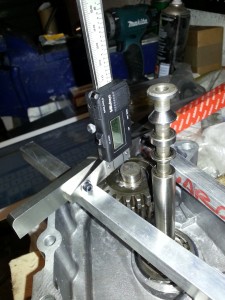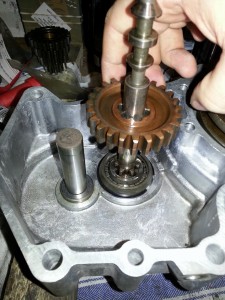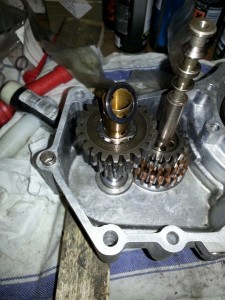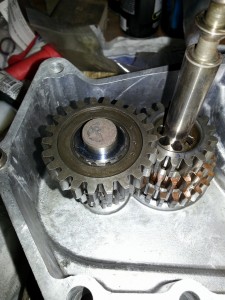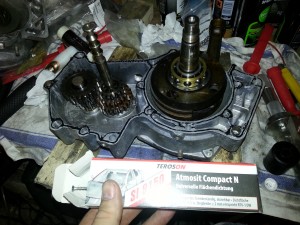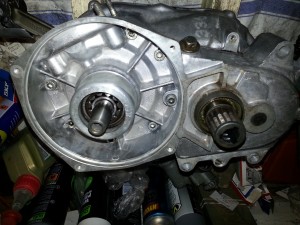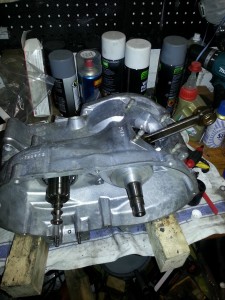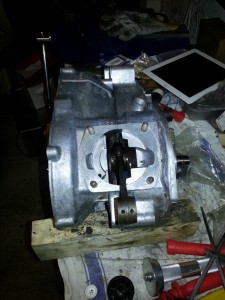Before re-assembling the engine, we’ll need to measure carefully what shims to use, to ensure the right tolerance in the engine. If you can re-use all shims, including those behind the crank bearings, it still pays to measure to ensure you have the right play. Especially when using paper or other gaskets that change the overall width of the engine. Tolerances are tight (0.1 mm for the crankshaft!)
First we’ll do the crankshaft; that one’s easy. We start by measuring the thickness of the crank, including the inner bearing case:
Measure three times and average the outcome. In my case 83.37, 83.36, 83.44. It pays to have a better digital caliper. This cheap chinese one isn’t great.
This gives you the width that needs to fit between the engine halves. The next logical step is to use a flat ruler with a depth gauge to measure the distance from the engine half to the crank shaft bearing seat:
In my case 41.95 and 42.02. Add these two and subtract the width of the crankshaft from this: 41.95 + 42.02 – 83.39 = 0.58. This means the play without any shims is 0.58 mm. This may not sound like much, but Zündapp recommends between 0.1 and 0.2 mm play for the crankshaft. This means that 0.58 – 0.15 = 0.43mm would need to be taken out. We’ll use a 0.45 mm shim which is the closest match and leaves us with 0.13 mm of play. Just about in the middle of the range of play recommended.
There is no such thing as ‘just insert a shim’; I had mine laser cut by the fine folks at Hollinbrow in various thicknesses. A bit of an investment but enough to last various engines. They worked out at about 2 GBP per shim.
Next up is the gear stack. This one is a bit trickier. There are a few things to keep in mind:
- The fixed gear stack has the largest sprocket up. The loose stack has the largest sprocket at the bottom.
- The fixed stack gears are always above the loose. To ensure the fixed stack never touches the loose gear one down, we need to make sure that there are sufficient shims underneath the fixed stack, that the loose stack, including play, will never touch. This will be engine specific, so measure the smallest space between gears user a feeler gauge and make sure axial play in either direction of either gear stack will not allow gears to touch.
- The recommended play for the fixed gear stack is 0.2 mm.
For the fixed gear stack, you need to measure distance from the engine half to the fixed gear stack catch:
In my case 9.00 mm.
Next we’ll measure how far the fixed gear stack sticks out of the engine half. I use two rules to put the depth gauge on and subtract the difference for the right outcome:
Mine comes to 7.09 mm. The rulers are 15mm, so the gear is sticking out 7.91 mm, making the play 1.09 mm. That is about 0.9 mm too much. I have used standard order shims to reduce the play to 0.2 mm after checking the loose gears don’t touch with the shims used.
Play for the loose gear stack should also be measured, but in most cases should be correct, unless you replaced any of the gear wheels or final drive shaft bearing. The method is explained in the service manual in the documentation section.
Next step is to clean the engine halve edges thoroughly with degreaser to then apply a small bead of liquid rubber gasket (teroson atmosit) or a modern equivalent.
and screw the engine halves together after inserting the crankshaft. When done correctly (always tighten engine half screw in a cross wise pattern to distribute the load. Never only start at one end):

